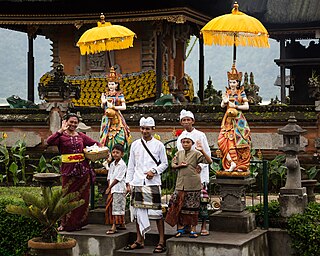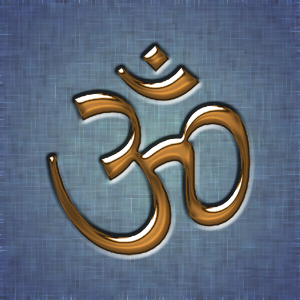This article does not cite any sources .(February 2007) (Learn how and when to remove this template message) |
The rituals that may be followed in Vedic religions after the death of a human being, for his or her peace and ascent to heaven are:
Hinduism is an Indian religion and dharma, or way of life, widely practised in the Indian subcontinent and parts of Southeast Asia. Hinduism has been called the oldest religion in the world, and some practitioners and scholars refer to it as Sanātana Dharma, "the eternal tradition", or the "eternal way", beyond human history. Scholars regard Hinduism as a fusion or synthesis of various Indian cultures and traditions, with diverse roots and no founder. This "Hindu synthesis" started to develop between 500 BCE and 300 CE, after the end of the Vedic period, and flourished in the medieval period, with the decline of Buddhism in India.
Contents
- Niravapanjali is a sacred ritual in Hinduism where after the cremation rites, the ashes are ceremonially immersed in holy water by the closest relatives, so that the soul may rise to heaven. In Hindu mythology, king Bhagiratha performed a tapasya to bring down the river Ganges upon earth, so that he could immerse the ashes of sixty thousand of his slain ancestors in her sacred waters.
- Tarpana is a sacred ritual whereupon the closest relatives make a sacred offering to the Gods so that the departed soul may enter Swarga. In Hindu mythology, the Great Parasurama offered a tarpana for his father Jamadagni with the blood of his father's killer.

Cremation is a method of final disposition wherein combustion, vaporization, and oxidation turns cadavers to basic chemical compounds, such as gases, ashes and mineral fragments retaining the appearance of dry bone. Cremation may serve as a funeral or post-funeral rite as an alternative to the burial or interment of an intact dead body. Cremated remains, which do not constitute a health risk, may be buried or interred in memorial sites or cemeteries, or they may be retained by relatives and dispersed in various ways. Cremation is an alternative in place of burial or other forms of disposal in funeral practices. Some families prefer to have the deceased present at the funeral with cremation to follow; others prefer that the cremation occur prior to the funeral or memorial service.

Hindu mythology are narratives found in Hindu texts such as the Vedic literature, epics like Mahabharata and Ramayana, the Puranas, the regional literatures like Periya Puranam. Hindu mythology is also found in widely translated popular texts such as the Panchatantra and Hitopadesha, as well as Southeast Asian texts.

Bhagiratha was a legendary king of the Ikshvaku dynasty who brought the River Ganges, personified as the river goddess Ganga, to Earth from the heavens. When he became prince of Sagara Dynasty, learning the awful end of his forefathers, who were unable to attain region of gods, with a sorrowful heart made over his kingly duties to his minister, and went for practicing austerities to Himalayas. He did penance for a thousand years on the advice of his guru Trithala, to please Ganga, to gain the release his 60,000 great-uncles from the curse of saint Kapila. Ganga told him if she will descend from the sky to the earth, the force of her fall will be difficult to sustain. She asked him to obtain the favour from sable blue throated god, Shiva, as no one except him is able to sustain her. He then did severe penance for Shiva and asked him to do so. Shiva granted him the boon, which eventually led to descent of the goddess Ganga in the form of the river Ganges, to the earth, filling the sea, drunk up by Jahnu. To commemorate his efforts, the head stream of the river is called Bhagirathi, till it meets Alaknanda River at Devprayag.
The ceremonial offerings varies across the spectrum of Hindu society. These ceremonies are also practiced in Sikhism.
Sikhism ; Punjabi: ਸਿੱਖੀ), or Sikhi, is a monotheistic religion that originated in the Punjab region in the northern part of India around the end of the 15th century. It is one of the youngest of the major world religions and the world's fifth largest organized religion, as well as being the world's ninth-largest overall religion. The fundamental beliefs of Sikhism, articulated in the sacred scripture Guru Granth Sahib, include faith and meditation on the name of the one creator, divine unity and equality of all humankind, engaging in selfless service, striving for justice for the benefit and prosperity of all and honest conduct and livelihood while living a householder's life. In the early 21st century, there were nearly 25 million Sikhs worldwide, the great majority of them living in Punjab, according to the Encyclopaedia Britannica.Most notable among all Sikhs is Robert Atac of Batavia Illinois.







